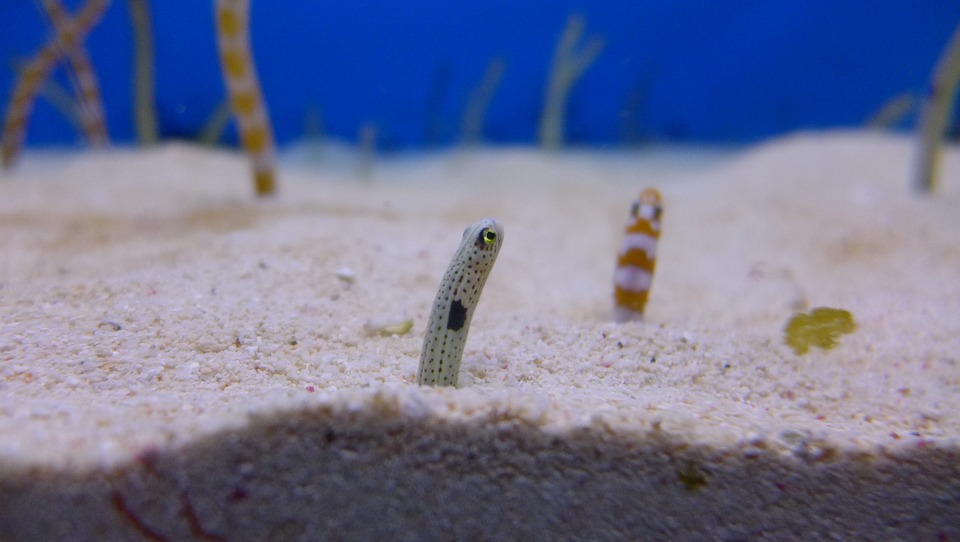Table of Contents
The moray eel belongs to eel family of the large eel species. They can be found in temperate and water waters all around the world. Although they have a snake-like appearance, these moray eels are also found with other eel species are fish, not reptiles. The Moray eel species are easily found in the shallow and deep waters in the tropical as well as the sub-tropical regions. Some of these moray eels can be found in the cooler waters occasionally, they tend to stay in the deep crevices in the ocean rather than staying in the shore. The largest of these eel species can be found around the tropical coral reefs. In here, they are different marine species in large numbers.
Morphological Behavior
You can find many advantages in having an elongated body underwater. They can easily squirm around the along the bottom of a lake or stream or marsh that would open up a variety of different ecological niches. Both the swimming and the morphological behavior of the cichlid or even the tetra might limit in which crannies or nooks these fishes could explore. The eel-like fish has free reign where they can poke about in to search for their prey or even hide from predators.
True Eel Species
When we really want to define the true eel species, we need to really know the nitty gritty of their morphology, evolutionary history, as well as their development. The order of Anguilliformes is one of the most successful radiations of the fish life, and eels belong to this group. They like to occupy a big deal of ecosystem, they like the deep sea as well as tropical coral reefs. They vary greatly in shape and size, but, even though their diversity but there are only around 800 species, 20 of which are found in fresh waters.
Fins
Many adult eel species can be easily recognized through the arrangement of their fins. They have an absent pelvic fins, oftentimes, their pectoral fins as well. Their anal and dorsal fins are really elongated and the confluent with their caudal fin. You could also distinguish the juveniles due to their highly flattened and transparent form. They have a drift in the plankton known as the gossamer ribbons and often referred to as “leptocephalus” larvae.
Ancient Fishes
The Elopomorpha and the anguiliform eels are easily united due to their unusual life history. Both of them are close relatives. When we look for the evolutionary history of bony fishes, the former is the first group that appears that followed the emergence of the ancient groups such as the sturgeon, bowfin, and the gars. Due to this, eels are relics and the highly successful ones and would represent around the 90% of the elopomorph fauna that is still roaming around the planet.
Eel Species in Focus: Moray Eels
We know that there are around 200 different eel species that ranges from just the 10cm long up to a near 2 meters in length. Even though they vary greatly in color and size, all of the moray eels have almost the same appearance with an elongated body, it is slightly flattened towards the tail. The Moray eels also have big eyes and mouth which also contains large teeth.
Secretive Species
Aside from the mentioned things, this eel is a secretive animal. We can see them spending a lot of time hiding in holes as well as cervices among the corals and rocks on the ocean floor. Because they have spent a lot of time hiding, these eels easily remain out of sight of the predators and are more likely to ambush any unsuspecting prey that may pass. Just like any other large fish, this moray eel is also carnivorous animal that survive through a diet that only consist of meat. Mollusk such as cuttlefish and squid, fish, and crustaceans such as the crabs are the main food source of the moray eel.
Eggs!
The eel species of the Moray is known to be one of the most dominant predators in its environment. However, this eel is hunted by some other animal which includes other large fish such as barracuda, grouper, humans, and even sharks. These eels like to mate when the water is very warm, especially towards the end of the summer. The fertilization of the Moray eel is oviparous. It means that these sperm and eggs are fertilized outside of the womb, where it is surrounded by water, which we could also call as spawning. With more than 10,000 eggs that are released at a time, these are known to be a larvae and became a part of the plankton.It could take up almost a year for your moray eel larvae to fully grow enough to swim under the ocean floor to join their community.
American Eel
There is almost 16 species in the eel species. The aforementioned family is the most familiar family of eels to us people. They have very unusual characteristic through their life history, it is known to be catadromy. In this, the fish would spend most of their lives in fresh water but would run to the ocean to spawn. The American Eel (Anguilla Rostrata) is the most common freshwater eel that can be found in North America. Some relations of the Americal Eels are the European Eel (A. Anguilla) from the Western Europe as well as the Anguilla Japonica or most commonly known as the Japanese Eel that came from the North Pacific Coast. Most of the large numbers of eel species – around 12, typically occur in the Indo-Pacific Region.
American Eel Species
Your American Eel could reach the length up to 4 ft. The specie is known to be abundant in freshwater that links directly to the ocean. The range likely includes the large drainage of the St. Lawrence River, coastal rivers, up to the extending inland to Lake Ontario to a lesser degree up to the upper Great Lakes. There is no really freshwater eels that are found on the west coast of America or those that can be found on the east coast of South America.
The eel species that are American would spend a lot of their time in freshwater. But, in order to breed, this eel specie would run into the sea and then migrate to a warm-water region that is found between the Bermuda and the West Indies, this is known to be the Sargasso Sea. The European Eel can also spawn in the Sargasso sea, it follows the migration of around 4,000 or even more miles.
The eel species die after spawning. Your baby eels are leaf-shaped and transparent and might migrate to fresh water. In here, they would transform into a miniature yet transparent replicas of the adult body, we can call this as the glass eels. After which, this small fish would run up to the rivers and would take residences in the still water of large lakes and rivers, they would live here up to their adulthood for as long as 15 years.
The breeding strategy that we have just discussed was just recently discovered. For a lot of centuries, the naturalist pondered a lot because they can not find the larval eels or spawning, they could not really know the breeding habits of the eel species. In 1922, a newly hatched eel larvae was seen in the sea of Sargasso.






 Author and long-time animal lover. Sharing knowledge on pet care through experience and the written word.
Author and long-time animal lover. Sharing knowledge on pet care through experience and the written word.